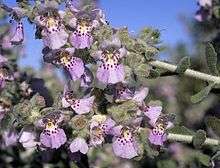Quoya (plant)
| Quoya | |
|---|---|
 | |
| Quoya atriplicina in Francois Peron National Park | |
| Scientific classification | |
| Kingdom: | Plantae |
| (unranked): | Angiosperms |
| (unranked): | Eudicots |
| (unranked): | Asterids |
| Order: | Lamiales |
| Family: | Lamiaceae |
| Genus: | Quoya Gaudich.[1] |
| Species | |
|
See text. | |
| Synonyms | |
| |
Quoya is a genus of flowering plants in the mint family, Lamiaceae and is endemic to Western Australia. Plants in this genus are shrubs with five petals joined to form a tube-shaped flower with four stamens of unequal lengths.
Description
Plants in the genus Quoya are evergreen shrubs densely covered with woolly hairs. The leaves are simple, egg-shaped to almost circular, arranged in opposite pairs and covered with branched hairs. The flowers are arranged in groups of 3 to 7, often forming short spikes and exhibit left-right symmetry. There are five sepals which are joined at their base, forming a short tube and five petals forming a straight or slightly curved tube with five lobes on the end, the upper lobes shorter than the lower ones. There are four stamens with the lower pair having reduced fertility. The fruit is a drupe with the sepals remaining attached.[2]
Taxonomy and naming
The genus was first described by Charles Gaudichaud-Beaupré in 1828 and the description was published in his book Voyage Autour du Monde ... sur les Corvettes de S.M. l'Uranie et la Physicienne. The type species is Quoya cuneata.[1][3]
The species of Quoya are:
- Quoya atriplicina (F.Muell.) B.J.Conn & M.J.Henwood
- Quoya cuneata Gaudich.
- Quoya dilatata (F.Muell.) B.J.Conn & M.J.Henwood
- Quoya loxocarpa (F.Muell.) B.J.Conn & M.J.Henwood
- Quoya oldfieldii F.Muell.
- Quoya paniculata F.Muell.
- Quoya racemosa Turcz.
- Quoya verbascina (F.Muell.) B.J.Conn & M.J.Henwood
Distribution
All species of Quoya are endemic to Western Australia.[4]
References
- 1 2 "Quoya". APNI. Retrieved 24 November 2016.
- ↑ Conn, Barry J.; Henwood, Murray J.; Streiber, Nicola (2011). "Synopsis of the tribe Chloantheae and new nomenclatural combinations in Pityrodia s.lat. (Lamiaceae)". Australian Systematic Botany. 24 (1): 1–9. doi:10.1071/SB10039.
- ↑ Gaudichaud-Beaupré, Charles (1828). Voyage Autour du Monde ... sur les Corvettes de S.M. l'Uranie et la Physicienne: Botanique. Paris. pp. 453–454. Retrieved 24 November 2016.
- ↑ "Quoya". FloraBase. Western Australian Government Department of Parks and Wildlife.